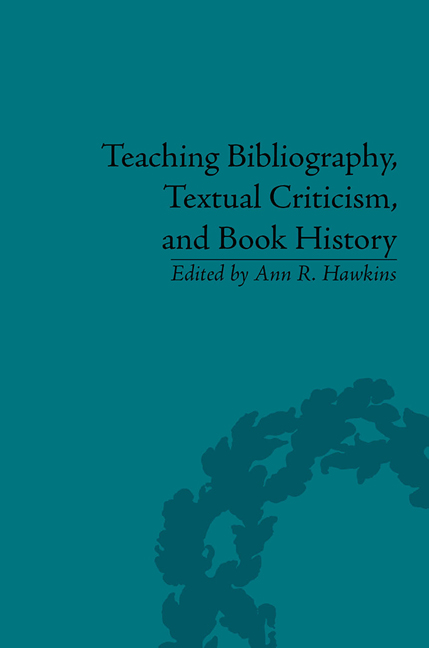Book contents
- Frontmatter
- Contents
- Notes on Contributors
- Foreword
- Introduction: Towards a pedagogy of Bibliography
- Part I Rationales
- Part II Creating and Using Resources
- Part III Methodologies
- Teaching ‘History of the Book’
- Teaching Bibliography and Research Methods
- Teaching Textual Criticism
- 20 How Things Work: Teaching the Technologies of Literature
- 21 ‘Not to Pick Bad from Bad, But By Bad Mend’: What Undergraduates Learn from Bad Editions
- 22 Book History and Reader-Response Theory: Teaching Shakespeare's Romeo and Juliet and King Lear
- 23 Textual Criticism: Students as Book Detectives and Scholarly Editors
- Afterword
- Part V Resources
- Index
20 - How Things Work: Teaching the Technologies of Literature
from Teaching Textual Criticism
- Frontmatter
- Contents
- Notes on Contributors
- Foreword
- Introduction: Towards a pedagogy of Bibliography
- Part I Rationales
- Part II Creating and Using Resources
- Part III Methodologies
- Teaching ‘History of the Book’
- Teaching Bibliography and Research Methods
- Teaching Textual Criticism
- 20 How Things Work: Teaching the Technologies of Literature
- 21 ‘Not to Pick Bad from Bad, But By Bad Mend’: What Undergraduates Learn from Bad Editions
- 22 Book History and Reader-Response Theory: Teaching Shakespeare's Romeo and Juliet and King Lear
- 23 Textual Criticism: Students as Book Detectives and Scholarly Editors
- Afterword
- Part V Resources
- Index
Summary
I'm interested in how things work. Many of my colleagues will also own up to that: they're interested in how narrative works, or how culture works, or how poems or sentences work. The keyword in my first sentence, however, is ‘things’, I am (especially) interested in how things work (‘made objects’ to use the term favored by Henry Petroski in his book-length history of the pencil). Often in English departments, however, We're not much interested in made objects, in things. We're interested in language, ideas, and discourse, as embodied and expressed by ‘texts’. This is, of course, a gross generalization, but it is a generalization broadly upheld in the public language we use to represent ourselves to the outside world. The mission statement of the department in which I teach, which I select only because it is typical, reads as follows: ‘to give students a sense of the history and variety of literature written in English’ ‘to introduce students to the debates about literature and language’ and ‘to use the critical study of literature and language to help students think carefully and express themselves well’. What this statement (and many others like it) fails to capture is much sense that language and literature are phenomena embodied by made objects, actual things.
I believe it's important to know how things work, and more specifically (for us, as literary scholars) to know how textual things work. One of my favorite examples of what I sometimes call the technology of literature involves William Blake, routinely taught as a poet, but in his own lifetime a printer, engraver, and artist.
- Type
- Chapter
- Information
- Teaching Bibliography, Textual Criticism, and Book History , pp. 155 - 160Publisher: Pickering & ChattoFirst published in: 2014



